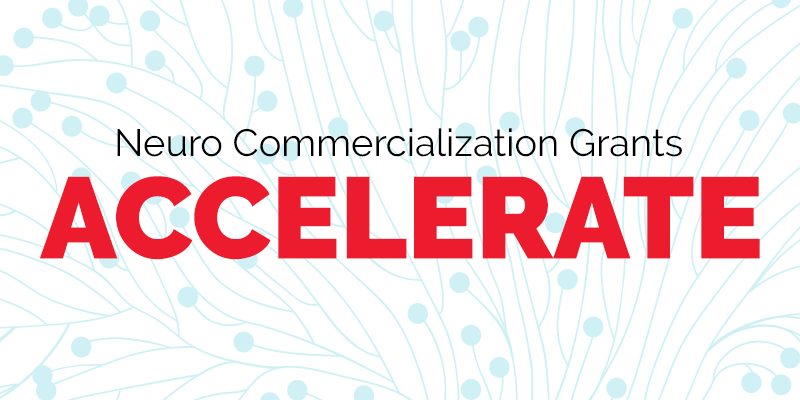Overview
The Healthy Brains, Healthy Lives (HBHL) initiative is a high profile, interdisciplinary initiative located at McGill University, and made possible with support from the Canada First Research Excellence Fund (CFREF). HBHL’s strategic priorities are represented by its four Research Themes.
The objective of the Accelerate Grants is to support research aimed at improving the commercial potential of a neuroscience-related technology and to position it for commercial development.
Note: To be eligible for HBHL’s Accelerate Grants, applicants must have either a) successfully fulfilled all of the requirements of the Ignite phase and received approval from the HBHL Innovation Committee and NeuroSphere team to apply to the accelerate phase, or b) met with the NeuroSphere staff (including the Entrepreneur in Residence) to discuss the proposed project in depth to determine its suitability, in addition to receiving approval from the HBHL Innovation Committee to apply to the accelerate phase.
|
Funds available |
|
|---|---|
|
Timeline |
Open program: Applicants may apply at any time once they are able to meet program eligibility requirements. |
|
Application process |
Prerequisites:
1. Invitation to apply To be eligible for HBHL’s Accelerate Grants, applicants must have either a) successfully fulfilled all of the requirements of the Ignite phase and received approval from the HBHL Innovation Committee and NeuroSphere team to apply to the accelerate phase, or b) met with the NeuroSphere staff (including the Entrepreneur in Residence) to discuss the proposed project in depth to determine its suitability, in addition to receiving approval from the HBHL Innovation Committee to apply to the Accelerate phase. 2. Eligibility review The NeuroSphere team will assess the eligibility of applications based on the following criteria: Applicant Eligibility
Notes:
Intellectual Property
Allowable Costs Funding must go towards direct support of technology maturation (i.e., personnel, materials and supplies). Business case and model evaluation, as well as strategic planning, may also be considered as allowable costs. Equipment is not an eligible expense. Other ineligible expenses include market studies, patent searches or filling, maintenance costs or salaries associated with commercial development. Although these activities are not eligible, I+P and NeuroSphere staff can provide assistance in these areas. Application Completeness: See table below The NeuroSphere team is available to provide assistance with the application. 3. Peer Review Once the application’s eligibility and relevance has been validated, a peer review committee will be formed to review the scientific excellence and commercialization potential of the application based on the following criteria:
4. Strategic Selection and Final Approval Upon completion of the peer review, the NeuroSphere staff will submit the application to the HBHL Innovation Committee for final decision and approval. To reach a funding decision, the HBHL Innovation Committee will consider both the results of the peer review as well as the strategic investment value of the application in contributing to HBHL’s innovation objectives (e.g., remaining funding, priority areas, continued support to promising existing projects, etc.). 5. Results and Post-Awards
6. Responsibilities of Successful Applicants Successful applicants are required to:
|
|
Submission |
Complete the online application form. See the Application Process section below for further information and details about the required application package. |
Application
All application packages must be submitted online through the Accelerate Grant application form. Please use the templates provided below and upload all parts as a single PDF application package named as “Lastname_Firstname_Accelerate.pdf”.
|
Proposal |
Access the Accelerate Proposal template (upload as part of single PDF application package). In a maximum of 10 pages, describe the research project for which funding is requested. Refer to the evaluation criteria. Number the pages and indicate the Applicant’s name in the top right corner of each page. The Research Project should contain the following sections (with required space limitations): 1. Overview (1 page) Description of the technology/invention.
2. R&D Technical Plan (5 to 6 pages)
3. Maturation/Commercialization Plan (2.5 to 3.5 pages)
4. EDI (1/2 page): Should include: • Describe the manner in which the activities of your research team, and the teams) of any collaborators, advance McGill's commitment to Equity, Diversity, & Inclusion (EDI). View examples of practices of practices that you can implement in your research design if you have not done so already. Applicant must include all the necessary information (including tables, figures and a list of references) within 10 pages. Please note that extra pages will be removed from your application. When completing the EDI sections of the application for HBHL Start-up Funds, applicants must protect the privacy and confidentiality of others. How an individual self-identifies is considered personal and confidential information and should not be disclosed without that person’s consent. |
|---|---|
|
Budget |
Access the Accelerate Budget template (upload as part of single PDF application package) Provide details of the anticipated expenses and how they were calculated. Justify why these expenses are necessary to the project. Mention any relevant quotes from suppliers for materials or services >$10,000. Specify any co-funding contributions from collaborators, industrial partners or foundations. |
|
Letters of Support |
(Upload as part of single PDF application package) Provide a letter of support from the investment partner(s). The letter(s) must be on official letterhead, confirm the financial commitment and outline the timelines and contributions to the project (must be a cash investment. In-kind contributions are not eligible). The total of the financial commitments must match the HBHL contribution. |
| CIHR Training Module Certificate |
Application PDF package must include an electronic certificate of completion (incl. name and date) from at least one of CIHR’s Online Training Modules on Integrating Sex and Gender in Health Research. |

